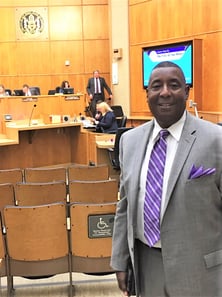
By Robert Calloway
2019 PSAR President
It was my honor to serve as your 2019 PSAR President. I’d like to take a moment to express my appreciation to the 2019 officers, directors, committee chairs and to every PSAR member.
It was my honor to serve with such a great team.Team spirit is never accidental; it is always intentional. The more credit you give to others, the more you develop a team spirit. It’s that simple.
You can’t build a team without trust. Trust is the emotional glue that binds a team together. I’m grateful for the trust and loyalty that I received from the PSAR board, staff and every member.
Our theme for 2019 was “Salute to Service.” Thanks to all of you who participated in related events and were dedicated to this theme. It was a year when our members definitely stepped up and served our association by committing themselves to service and to our mission of empowering our members. PSAR’s mission statement is: “We empower our members to flourish while being accountable to each other, our clients and our community.” Our members are also self-empowered to take control of their own destiny and careers.
Here’s a personal, straight-from-the-shoulder admission: I have learned that nothing is more refreshing than to serve and giveback by getting involved. It’s your attitude that is most important. There’s something very authentic in participating with the desire to help others. Nothing to prove, nothing to lose. So, it was very gratifying to watch in 2019 our members experience greater rewards and the benefits of PSAR membership, as well as a sense of satisfaction, by stepping forward, participating and serving on or in a PSAR committee or an event.
Every PSAR member is unique with different strengths and talents. Every one of us is equipped with different skills and abilities. I’m so grateful that you all gave of yourselves selflessly.
You shared yourselves and your resources in 2019 on behalf of our association. You are all leaders. All leaders are learners. The moment you stop learning, you stop being a leader. Throughout the year, I witnessed again and again our members willing to learn. I genuinely applaud your performance and care about you. I greatly appreciate your contributions during my year as President.
Your dedication and commitment served as a vital link in the chain which drove our association. Achievement and success don’t happen by accident. Breakthroughs come after hard work and embracing new ideas. I’m thankful for your support of PSAR and the part you played in maintaining our high performance standards and commitment to excellence.
During 2019, there were many highlights. Here are some notable benchmarks and accomplishments:
- 190 training classes, 23 unique events and 600 marketing sessions;
- Membership increased by 10 percent
- Services expanded by opening a third PSAR service center in Clairemont Mesa, at 4340 Genesee Ave., Suite 203, San Diego, labeled the Central San Diego Service Center;
- A new weekly property marketing pitch meeting was launched, called “City Pitch,” held at 9 a.m. every Tuesday morning, at the PSAR Central San Diego Service Center
- Significant increase in access to more technology and listing data by joining the California Regional Multiple Listing Service (CRMLS)
- Glide 2.0 and SavvyCard added as new member benefits
- Our El Cajon office building mortgage paid off
- $13,500 awarded to four local nonprofits, including South Bay Community Services, Unity 4 Orphans, Meals on Wheels and San Ysidro Health Center, as a result of fundraising at two PSAR events,the PSAR 2019 Realtor Games, held in June, and the PSAR 2019 Zombie Run-Walk, held in October
- A new Local Area Disclosures (LAD) publication, covering San Diego County, was published in partnership with the North San Diego County Association of REALTORS® (NSDCAR). The new LAD contains disclosure information relating to properties in the San Diego region
- Recognition by the El Cajon City Council for a grant that created a website featuring resources and information to assist homeless people in the East County
- Assistance provided to the City of San Diego by writing the “Companion Unit Handbook,” a 38-page guide to help homeowners better navigate the process of constructing a companion unit, also known as a granny flat or accessory dwelling unit (ADU), on their property
- Guidance provided to the La Mesa City Council, City of Chula Vista and San Diego County Board of Supervisors on ADUs in support of property owners and as a way to address the region’s housing supply and affordability crisis
- Organization of “Small Homes, Big Impact,” a free forum and resource fair on ADUs that was sponsored by AARP, formerly the American Association of Retired Persons, and held in October at the La Mesa Community Center
- Promotion of the CRMLS/Mexico MLS data-share as a presenter at the AMPI (Asociacion Mexicana de Profesionales Inmobiliarios) national convention (AMPI is Mexico’s counterpart to the National Association of REALTORS®)
- Development of relationships with Baja Associations via meetings in Los Cabos and La Paz
- Hosting of the second annual Global Council Forum, that featured speakers offering tips on how to deal with financial, legal and cultural differences and work deals with international agents from other countries
- Recognition by the San Diego County Taxpayers Association with a Golden Watchdog Award for PSAR’s assistance to the San Diego County Assessor’s Office with a program that is helping disabled military veterans achieve homeownership
- Recognition by the California Board of Equalization (BOE), a state agency, for PSAR’s leadership role in a housing affordability program that is assisting disabled military veterans in San Diego achieve homeownership, stay in their homes and save money on their property taxes
- Advising the San Diego County Assessor-Recorder-Clerk on a number of homeownership initiatives that assisted more than 8,000 local disabled veterans, a 30 percent increase from the previous year
- Coordinating the trip of 27 REALTORS® to Sacramento to advocate for homeownership
- Hosting Mike Ferry's massive sales training event
In conclusion, let me encourage all of you to continue to stay involved by volunteering and serving on a PSAR committee. Don’t just show-up, volunteer. Find your passions, utilize your strengths, be a participant, not just an observer and you will get more out of PSAR. You will develop your skills, advance your career and the experience will be rewarding to you both personally and professionally. While no one is capable of doing everything, everyone is capable of doing something. All of us can extend the reach of PSAR by building relationships and spreading the word about the many benefits PSAR offers.
In 2020, take advantage of the available opportunities as we work together and commit ourselves to increase business and leadership opportunities and develop relationships. Together, let’s send one very clear, strong, unmistakable message that we are here to build business networks and community, share resources and experiences, develop professionally through educational opportunities, contribute to economic development and influence the real estate industry’s future. Thanks for being a committed member to PSAR in 2019. It was a wonderful year. Fair Winds and Following Seas!





